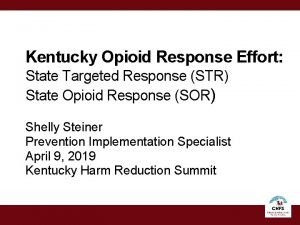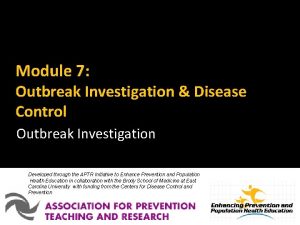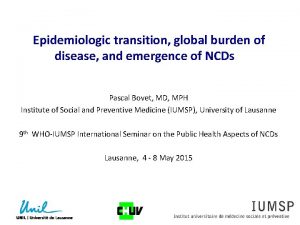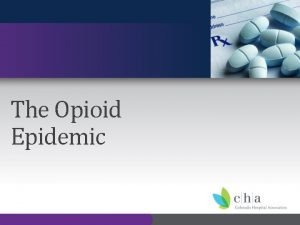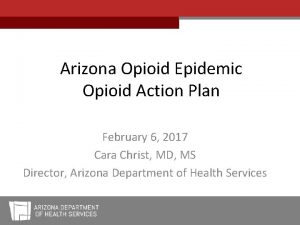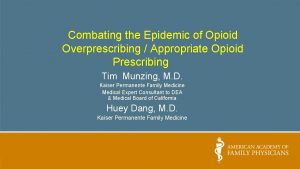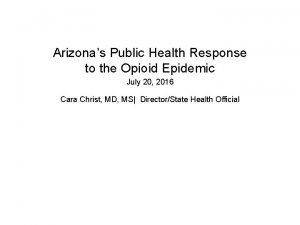The Opioid Epidemic HHS and SAMHSA Response Christopher









- Slides: 9

The Opioid Epidemic: HHS and SAMHSA Response Christopher M. Jones, Pharm. D, MPH Director, National Mental Health and Substance Use Policy Laboratory Substance Abuse and Mental Health Services Administration U. S. Department of Health and Human Services

Outline National Trends Snapshot HHS Opioid Strategy and SAMHSA’s Role National Mental Health and Substance Use Policy Laboratory Questions

1968 1969 1970 1971 1972 1973 1974 1975 1976 1977 1978 1979 1980 1981 1982 1983 1984 1985 1986 1987 1988 1989 1990 1991 1992 1993 1994 1995 1996 1997 1998 1999 2000 2001 2002 2003 2004 2005 2006 2007 2008 2009 2010 2011 2012 2013 2014 2015 2016 Drug overdose deaths per 100, 000 population (age-adjusted) Sustained impact of the opioid crisis Drug Overdose Deaths, 1968 -2016 25 Opioids 20 15 10 Heroin Source: CDC WONDER, 1968 -2016 Cocaine 5 0

Opioid overdose deaths at unprecedented Levels Any Opioid Commonly Prescribed Opioids Heroin Synthetic Opioids 14 70, 000 12 60, 000 10 50, 000 8 40, 000 6 30, 000 4 20, 000 2 10, 000 0 0 1999 2000 2001 2002 2003 2004 2005 2006 2007 2008 2009 2010 2011 2012 2013 2014 2015 2016 Source: CDC National Vital Statistics System Number of Drug Overdose Deaths per 100, 000 Population (Age-Adjusted) Drug Overdose Deaths

Origins of the epidemic and a path to solutions Increases in opioid-related harms fundamentally tied to two primary issues 1. Significant rise in opioid prescribing that began in the mid-to-late 1990 s Prescribing opioids for different types of chronic pain conditions that we now know do not often benefit from opioids in the long-term Prescribing higher doses and for longer durations Prescribing opioids in combination with medications like benzodiazepines which can substantially increase risk for overdose 2. Lack of health system and provider capacity to identify, engage, and provide high-quality, evidencebased opioid addiction treatment, in particular mediation-assisted treatment with naltrexone, buprenorphine, or methadone Majority of people with opioid addiction in the U. S. do not receive treatment Even among those who do get treatment, many do not receive evidence-based care Lack of access to and provision of treatment is a significant contributor to rising rates of heroin and fentanyl use, rates of injection drug use, and overdose death

HHS Opioid Strategy Improving access to prevention, treatment, and recovery support services Advancing the practice of pain management Targeting availability and distribution of overdose-reversing drugs Comprehensive Evidence-based Targets drivers of epidemic Flexible to emerging threats Supporting cuttingedge research Strengthening timely public health data and reporting

SAMHSA role in the HHS Opioid Strategy Supporting state capacity for prevention, treatment and recovery State Substance Abuse Prevention and Treatment Block Grant State Targeted Response to the Opioid Crisis grants MAT Prescription Drug and Opioid Addiction (MAT PDOA) grants Building Communities of Recovery grants First Responder naloxone training grants Prevent Prescription Drug/Opioid Overdose Related Deaths naloxone grants PPW grants, including CARA State Pilot grants Providing training and technical assistance Providers Clinical Support System – MAT Addiction Technology Transfer Centers STR Technical Assistance grant OTP and DATA 2000 waiver oversight and training Advancing innovation and adoption of evidence-based interventions through evaluation and policy and data analysis

National Mental Health and Substance Use Policy Lab Created in 21 st Century Cures Act to: Identify, coordinate, and facilitate the implementation of policy changes likely to have a significant effect on mental health, mental illness, recovery supports, and the prevention and treatment of substance use disorder services Carry out activities to continue to encourage innovation and disseminate evidence-based programs and practices Expanding, replicating, or scaling evidence-based programs, including through evaluation of innovative service delivery models Improve data collection to inform programmatic and policy efforts

Thank You Questions? Christopher. Jones@SAMHSA. HHS. GOV
